INTRODUCTION
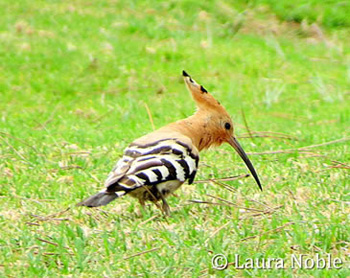 My wife, daughter and I spent a week in Portugal, based in Albufeira for a week from 21st April. Although I am a keen birder the rest of the family likes to do other things so we weren’t focusing on birds only.
My wife, daughter and I spent a week in Portugal, based in Albufeira for a week from 21st April. Although I am a keen birder the rest of the family likes to do other things so we weren’t focusing on birds only.
Our hotel was at Praia de Oura about a mile from the centre of Albufeira. We didn’t like it and if we go again we would try and stay in a more rural location. But it was close to the sea and there were a couple of small wooded valleys within easy walking distance. I had early morning walks while the family slept in and saw a few interesting birds such as Spotless Starling, Serin, Sardinian Warbler, Yellow-legged Gull, Gannet, European Bee-eater, Hoopoe, Alpine Swift and quite a few Iberian Magpies. The last were a surprise to me as I had expected to have to search quite hard to find them. I don’t think that I failed to see at least one on any day that I was in the Algarve.
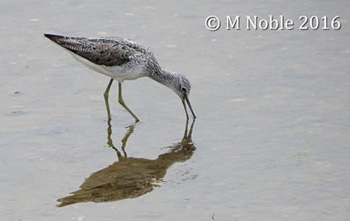 We used A Birdwatchers' Guide to Portugal, the Azores and Madeira Archipelagos
We used A Birdwatchers' Guide to Portugal, the Azores and Madeira Archipelagos by Colm Moore, Gonçalo Elias and Helder Costa (Prion 2014) as our site guide. The directions were reasonably clear and up-to-date although it would have helped to have some more detailed maps in the book. We used a smart-phone for navigation and the combination of that and the book was just about OK.
by Colm Moore, Gonçalo Elias and Helder Costa (Prion 2014) as our site guide. The directions were reasonably clear and up-to-date although it would have helped to have some more detailed maps in the book. We used a smart-phone for navigation and the combination of that and the book was just about OK.
For those who have not been to Portugal before, the driving is fairly relaxed. People were patient with me as I hesitated at crossroads. The speed limits were completely mystifying and as far as we could tell largely ignored! Parking was never an issue.
 SITES VISITED & BIRDS SEEN
SITES VISITED & BIRDS SEEN
The first outing we did was to Quinta do Lago, just to the west of Faro, on 23rd April. We found the ‘rough track’ referred to in Moore & co but rather than following it we parked in the grounds of the nearby golf club. No one objected and it was handy to be able to buy drinks and use the facilities. 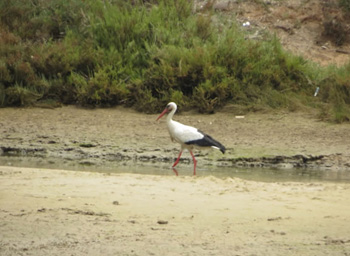 Near the car we had excellent views of a feeding Hoopoe. Assuming that we were in the right place, we didn’t see any sign saying ‘discovery trail’ but following the rough track for about a km brought us to a large lake with a massive hide overlooking it. (We saw quite a few Iberian Magpie and a couple of European Bee-eater along the trail.) We didn’t bother with the hide as Western Swamp-hens were wandering across the golf course. We could see Coot, Black-headed Weaver, Common Pochard and various other waterbirds but, somewhat to our surprise, we discovered that we were on the end of a large, well-marked reserve consisting of a tidal estuary and salt-marshes (not mentioned in the guide book). There was another, smaller hide, looking across this area and a well-made path heading approximately towards Faro. We saw a good variety of waders, including Turnstone, Greenshank, Whimbrel, Grey Plover, Ringed Plover and Sanderling as well as White Stork and Little Tern. There were a few Yellow Wagtail and a Lark which I assume was Crested. There were Red-rumped Swallow in the area, too. We didn’t walk very far but clearly the area had great potential.
Near the car we had excellent views of a feeding Hoopoe. Assuming that we were in the right place, we didn’t see any sign saying ‘discovery trail’ but following the rough track for about a km brought us to a large lake with a massive hide overlooking it. (We saw quite a few Iberian Magpie and a couple of European Bee-eater along the trail.) We didn’t bother with the hide as Western Swamp-hens were wandering across the golf course. We could see Coot, Black-headed Weaver, Common Pochard and various other waterbirds but, somewhat to our surprise, we discovered that we were on the end of a large, well-marked reserve consisting of a tidal estuary and salt-marshes (not mentioned in the guide book). There was another, smaller hide, looking across this area and a well-made path heading approximately towards Faro. We saw a good variety of waders, including Turnstone, Greenshank, Whimbrel, Grey Plover, Ringed Plover and Sanderling as well as White Stork and Little Tern. There were a few Yellow Wagtail and a Lark which I assume was Crested. There were Red-rumped Swallow in the area, too. We didn’t walk very far but clearly the area had great potential.
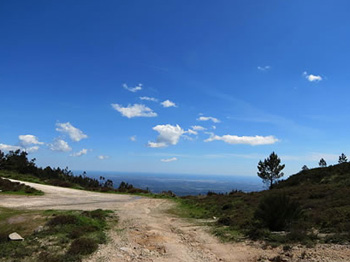 On 24th we drove up to Serra de Monchique, a serra being a range of hills. We didn’t see much in the town (White Wagtail) but decided to drive higher up the hill towards Fóia, at 950m the highest point in the Algarve. We stopped before the summit at a little lay-by and explored on foot. The vegetation was very scrubby. It was one of those places where you could hear more birds than you could see. The only definite sightings were Rock Bunting, Nightingale and Stonechat though I’m pretty sure that a raptor that flashed past was a Sparrowhawk. I could see two distant raptors which looked like buzzards.
On 24th we drove up to Serra de Monchique, a serra being a range of hills. We didn’t see much in the town (White Wagtail) but decided to drive higher up the hill towards Fóia, at 950m the highest point in the Algarve. We stopped before the summit at a little lay-by and explored on foot. The vegetation was very scrubby. It was one of those places where you could hear more birds than you could see. The only definite sightings were Rock Bunting, Nightingale and Stonechat though I’m pretty sure that a raptor that flashed past was a Sparrowhawk. I could see two distant raptors which looked like buzzards.
Rock Bunting habitat at Fóia. This is the view to the West and the sea could be seen in the distance. This point is probably about 850m above sea-level.
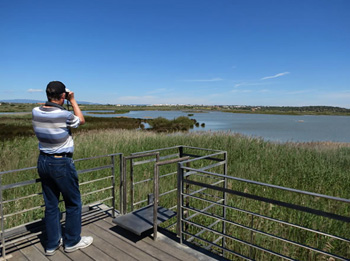 The next day we visited the historic capital of the Algarve, Silves. There were lots of swifts but I’m afraid I never managed to figure out which! The same applied to a Kestrel although it must surely have been Common. The main highlight here was lovely views of nesting White Stork from the castle battlements.
The next day we visited the historic capital of the Algarve, Silves. There were lots of swifts but I’m afraid I never managed to figure out which! The same applied to a Kestrel although it must surely have been Common. The main highlight here was lovely views of nesting White Stork from the castle battlements.
Our last major outing was to Lagoa dos Salgados on 26th. This is my idea of birding heaven – masses of birds, a great boardwalk, some ‘blinds’, a very nice café (near the beach), other birders to compare notes with, sunny weather but not too hot, and also plenty of wildflowers, butterflies a terrapin etc. I am 99% certain I saw a Lesser Emperor Dragonfly with a vivid sky blue base to its abdomen.
The birds just kept on coming. First, I finally connected with the hoped for Greater Flamingo, about 12 of them, and not too distant.
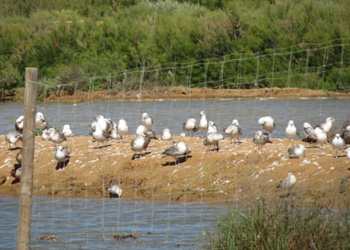 I also saw an adult Audouin’s Gull – in among the masses of Yellow-legged and Lesser Black-backed gulls. Other highlights were Black-winged Stilt, Avocet, Western Swamphen, Ruddy Shelduck (although it may have been a hybrid), Whiskered and Little Tern, Purple and Grey Heron, Cattle Egret, Little Egret, Little Bittern, Kentish Plover, Crested Lark, Fan-tailed Warbler, European Bee-eaters (close), Hoopoe, Iberian Magpie and even a Common Sandpiper. I think I saw a Spoonbill flying past but I was too busy looking at something else to verify it.
I also saw an adult Audouin’s Gull – in among the masses of Yellow-legged and Lesser Black-backed gulls. Other highlights were Black-winged Stilt, Avocet, Western Swamphen, Ruddy Shelduck (although it may have been a hybrid), Whiskered and Little Tern, Purple and Grey Heron, Cattle Egret, Little Egret, Little Bittern, Kentish Plover, Crested Lark, Fan-tailed Warbler, European Bee-eaters (close), Hoopoe, Iberian Magpie and even a Common Sandpiper. I think I saw a Spoonbill flying past but I was too busy looking at something else to verify it.
Some of the hundreds of gulls at the Lagoa. Most were yellow-legged but there were other species among them.
That was pretty much it, bird-wise. But I’ll finish with a couple of shots taken at the hotel – and a list of birds seen.

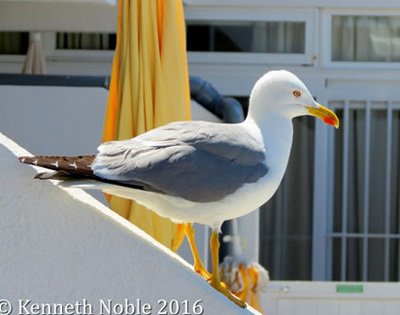
|
Species |
|
Location |
|
Date |
1 |
Gadwall - Anas strepera |
Ria Formosa - Quinta do Lago |
23-Apr-16 |
2 |
Eurasian Wigeon - Anas penelope |
Ria Formosa - Quinta do Lago |
23-Apr-16 |
3 |
Mallard - Anas platyrhynchos |
Ria Formosa - Quinta do Lago |
23-Apr-16 |
4 |
Northern Shoveler - Anas clypeata |
Lagoa dos Salgados |
26-Apr-16 |
5 |
Red-crested Pochard - Netta rufina |
Ria Formosa - Quinta do Lago |
23-Apr-16 |
6 |
Common Pochard - Aythya ferina |
Ria Formosa - Quinta do Lago |
23-Apr-16 |
7 |
Little Grebe - Tachybaptus ruficollis |
Ria Formosa - Quinta do Lago |
23-Apr-16 |
8 |
Greater Flamingo - Phoenicopterus roseus |
Lagoa dos Salgados |
26-Apr-16 |
9 |
White Stork - Ciconia ciconia |
Ria Formosa - Quinta do Lago |
23-Apr-16 |
10 |
Northern Gannet - Morus bassanus |
Praia da Oura |
25-Apr-16 |
11 |
Great Cormorant - Phalacrocorax carbo |
Praia da Oura |
22-Apr-16 |
12 |
Little Bittern - Ixobrychus minutus |
Lagoa dos Salgados |
26-Apr-16 |
13 |
Grey Heron - Ardea cinerea |
Lagoa dos Salgados |
26-Apr-16 |
14 |
Purple Heron - Ardea purpurea |
Lagoa dos Salgados |
26-Apr-16 |
15 |
Little Egret - Egretta garzetta |
Ria Formosa - Quinta do Lago |
23-Apr-16 |
16 |
Cattle Egret - Bubulcus ibis |
Lagoa dos Salgados |
26-Apr-16 |
17 |
Western Swamphen - Porphyrio porphyrio |
Ria Formosa - Quinta do Lago |
23-Apr-16 |
18 |
Common Moorhen - Gallinula chloropus |
Ria Formosa - Quinta do Lago |
23-Apr-16 |
19 |
Eurasian Coot - Fulica atra |
Ria Formosa - Quinta do Lago |
23-Apr-16 |
20 |
Black-winged Stilt - Himantopus himantopus |
Lagoa dos Salgados |
26-Apr-16 |
21 |
Pied Avocet - Recurvirostra avosetta |
Lagoa dos Salgados |
26-Apr-16 |
22 |
Grey Plover - Pluvialis squatarola |
Ria Formosa - Quinta do Lago |
23-Apr-16 |
23 |
Kentish Plover - Charadrius alexandrinus |
Lagoa dos Salgados |
26-Apr-16 |
24 |
Common Ringed Plover - Charadrius hiaticula |
Ria Formosa - Quinta do Lago |
23-Apr-16 |
25 |
Common Sandpiper - Actitis hypoleucos |
Lagoa dos Salgados |
26-Apr-16 |
26 |
Common Greenshank - Tringa nebularia |
Ria Formosa - Quinta do Lago |
23-Apr-16 |
27 |
Common Redshank - Tringa totanus |
Ria Formosa - Quinta do Lago |
23-Apr-16 |
28 |
Whimbrel - Numenius phaeopus |
Ria Formosa - Quinta do Lago |
23-Apr-16 |
29 |
Ruddy Turnstone - Arenaria interpres |
Ria Formosa - Quinta do Lago |
23-Apr-16 |
30 |
Sanderling - Calidris alba |
Ria Formosa - Quinta do Lago |
23-Apr-16 |
31 |
Dunlin - Calidris alpina |
Ria Formosa - Quinta do Lago |
23-Apr-16 |
32 |
Black-headed Gull - Chroicocephalus ridibundus |
Lagoa dos Salgados |
26-Apr-16 |
33 |
Audouin's Gull - Ichthyaetus audouinii |
Lagoa dos Salgados |
26-Apr-16 |
34 |
Yellow-legged Gull - Larus michahellis |
Praia da Oura |
22-Apr-16 |
35 |
Lesser Black-backed Gull - Larus fuscus |
Praia da Oura |
26-Apr-16 |
36 |
Little Tern - Sternula albifrons |
Ria Formosa - Quinta do Lago |
23-Apr-16 |
37 |
Whiskered Tern - Chlidonias hybrida |
Lagoa dos Salgados |
26-Apr-16 |
38 |
Rock Dove - Columba livia |
Praia da Oura |
24-Apr-16 |
39 |
Eurasian Collared-Dove - Streptopelia decaocto |
Faro Airport Salinas |
21-Apr-16 |
40 |
Alpine Swift - Apus melba |
Praia da Oura |
24-Apr-16 |
41 |
Eurasian Hoopoe - Upupa epops |
Praia da Oura |
23-Apr-16 |
42 |
European Bee-eater - Merops apiaster |
Ria Formosa - Quinta do Lago |
23-Apr-16 |
43 |
Eurasian Jay - Garrulus glandarius |
Praia da Oura |
22-Apr-16 |
44 |
Iberian Magpie - Cyanopica cooki |
Praia da Oura |
22-Apr-16 |
45 |
Common Magpie - Pica pica |
Praia da Oura |
24-Apr-16 |
46 |
Crested Lark - Galerida cristata |
Lagoa dos Salgados |
26-Apr-16 |
47 |
Barn Swallow - Hirundo rustica |
Praia da Oura - cliff paths & coombs near hotel |
22-Apr-16 |
48 |
Red-rumped Swallow - Cecropis daurica |
Praia da Oura - cliff paths & coombs near hotel |
22-Apr-16 |
49 |
Common House-Martin - Delichon urbicum |
Faro Airport Salinas |
21-Apr-16 |
50 |
Great Tit - Parus major |
Praia da Oura |
23-Apr-16 |
51 |
Cetti's Warbler - Cettia cetti |
Ria Formosa - Quinta do Lago |
23-Apr-16 |
52 |
Reed-Warbler - Acrocephalus scirpaceus |
Lagoa dos Salgados |
26-Apr-16 |
53 |
Fan-tailed Warbler - Cisticola juncidis |
Lagoa dos Salgados |
26-Apr-16 |
54 |
Sardinian Warbler - Sylvia melanocephala |
Praia da Oura - cliff paths & coombs near hotel |
22-Apr-16 |
55 |
Nightingale - Luscinia megarhynchos |
Serra de Monchique - Fóia summit road |
24-Apr-16 |
56 |
Stonechat - Saxicola rubicola |
Serra de Monchique - Fóia summit road |
24-Apr-16 |
57 |
Blackbird - Turdus merula |
Praia da Oura |
22-Apr-16 |
58 |
Spotless Starling - Sturnus unicolor |
Praia da Oura |
22-Apr-16 |
59 |
Western Yellow Wagtail - Motacilla flava |
Ria Formosa - Quinta do Lago |
23-Apr-16 |
60 |
White Wagtail - Motacilla alba |
Monchique |
24-Apr-16 |
61 |
Rock Bunting - Emberiza cia |
Serra de Monchique - Fóia summit road |
24-Apr-16 |
62 |
Greenfinch - Chloris chloris |
Praia da Oura |
22-Apr-16 |
63 |
Goldfinch - Carduelis carduelis |
Faro Airport Salinas |
21-Apr-16 |
64 |
Linnet - Carduelis cannabina |
Praia da Oura |
23-Apr-16 |
65 |
Serin - Serinus serinus |
Praia da Oura |
24-Apr-16 |
66 |
House Sparrow - Passer domesticus |
Praia da Oura |
22-Apr-16 |
67 |
Black-headed Weaver - Ploceus melanocephalus |
Ria Formosa - Quinta do Lago |
23-Apr-16 |
Trip Report PDF version
Ken Noble

